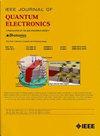Mitigating the Effects of Concave Damage by Adding a Lining Layer in a Ring-Core Fiber for Improving Propagation of Orbital Angular Momentum Modes
IF 2.1
3区 工程技术
Q3 ENGINEERING, ELECTRICAL & ELECTRONIC
引用次数: 0
Abstract
In order to support the transmission of orbital angular momentum (OAM) modes effectively, the ring-core fiber has received a lot of attention due to the similar structure of the electric field distribution with the intensity profile of OAM mode. Both photonic crystal fibers and other micro-structured fibers almost contain a ring-core structure to support the transmission of more OAM modes. However, the middle of the ring-core fiber is usually a large air hole, and such a structure makes it difficult to manufacture the ring-core perfectly. Concave damage may occur in the ring-core. The effects of concave damage on the transmission of OAM modes are analyzed. The concave damage leads to a large effective refractive index difference between the odd and even modes of vector mode, and a method for proper compensation is proposed. The lining is added to the inner side of the ring-core, which is made of the same material as the cladding, and slightly increasing the refractive index of the lining material promotes the performance of the compensation. After numerical simulation, the walk-off distance can be increased by a factor of 2–20 after compensation.通过在环芯光纤中添加衬里层来减轻凹面损伤的影响,从而改善轨道角动量模式的传播
为了有效地支持轨道角动量(OAM)模式的传输,环芯光纤因其电场分布结构与轨道角动量模式的强度分布图相似而备受关注。光子晶体光纤和其他微结构光纤几乎都包含环芯结构,以支持更多OAM模式的传输。然而,环芯光纤的中间通常是一个大的空气孔,这种结构使得环芯难以完美地制造。环芯可能出现凹形损伤。分析了凹损伤对OAM模态传输的影响。凹形损伤导致矢量模奇偶模之间的有效折射率差较大,并提出了适当的补偿方法。在环芯的内侧增加衬里,衬里的材料与包层相同,稍微增加衬里材料的折射率可以提高补偿的性能。经数值模拟,补偿后的行走距离可提高2-20倍。
本文章由计算机程序翻译,如有差异,请以英文原文为准。
求助全文
约1分钟内获得全文
求助全文
来源期刊

IEEE Journal of Quantum Electronics
工程技术-工程:电子与电气
CiteScore
4.70
自引率
4.00%
发文量
99
审稿时长
3.0 months
期刊介绍:
The IEEE Journal of Quantum Electronics is dedicated to the publication of manuscripts reporting novel experimental or theoretical results in the broad field of the science and technology of quantum electronics. The Journal comprises original contributions, both regular papers and letters, describing significant advances in the understanding of quantum electronics phenomena or the demonstration of new devices, systems, or applications. Manuscripts reporting new developments in systems and applications must emphasize quantum electronics principles or devices. The scope of JQE encompasses the generation, propagation, detection, and application of coherent electromagnetic radiation having wavelengths below one millimeter (i.e., in the submillimeter, infrared, visible, ultraviolet, etc., regions). Whether the focus of a manuscript is a quantum-electronic device or phenomenon, the critical factor in the editorial review of a manuscript is the potential impact of the results presented on continuing research in the field or on advancing the technological base of quantum electronics.
 求助内容:
求助内容: 应助结果提醒方式:
应助结果提醒方式:


